Abstract
The Bacillus cereus specific bacteriophage JBP901 has a broad host range spectrum among B. cereus isolates. JBP901, which belongs to the SPO1 group in the family Myoviridae, lyses 279 of 344 (81%) food and human isolates. B. subtilis (50 food isolates) and B. licheniformis (12 food isolates) were both insenstive to JBP901. JBP901 completely eradicated B. cereus in the fast fermented soybean product cheonggukjang with addition of a divalent cation in a food application study. Divalent and monovalent cations play essential roles in adsorption and post-adsorption phases of JBP901 infection, respectively.
Similar content being viewed by others
References
Haakensen M, Dobson CM, Deneer H, Ziola B. Real-time PCR detection of bacteria belonging to the Firmicutes Phylum. Int. J. Food Microbiol. 125: 236–241 (2008)
Drobniewski FA. Bacillus cereus and related isolates. Clin. Microbiol. Rev. 6: 324–338 (1993)
Granum PE, Lund T. Bacillus cereus and its food poisoning toxins. FEMS Microbiol. Lett. 157: 223–228 (1997)
Schoeni JL, Wong ACL. Bacillus cereus food poisoning and its toxins. J. Food Protect. 68: 636–648 (2005)
Ahmed AA, Moustafa MK, Martin EH. Incidence of B. cereus in milk and some milk products. J. Food Protect. 46: 126–128 (1983)
Wong HC, Chang MH, Fan JY. Incidence and characterization of Bacillus cereus isolates contaminating dairy products. Appl. Environ. Microbiol. 54: 699–702 (1988)
Park YB, Kim JB, Shin SW, Kim JC, Cho SH, Lee BK, Ahn J, Kim JM, Oh DH. Prevalence, genetic diversity, and antibiotic susceptibility of Bacillus cereus strains isolated from rice and cereals collected in Korea. J. Food Protect. 72: 612–617 (2009)
Kim SK, Kim KP, Jang SS, Shin EM, Kim MJ, Oh S, Ryu S. Prevalence and toxigenic profiles of Bacillus cereus isolated from dried red peppers, rice, and sunsik in Korea. J. Food Protect. 72: 578–582 (2009)
Oguntoyinbo FA, Oni OM. Incidence and characterization of Bacillus cereus isolated from traditional fermented meals in Nigeria. J. Food Protect. 67: 2805–2808 (2004)
Thorsen L, Azokpota P, Hansen BM, Hounhouigan DJ, Jakobsen M. Identification, genetic diversity and cereulide producing ability of Bacillus cereus group strains isolated from Beninese traditional fermented food condiments. Int. J. Food Microbiol. 142: 247–250 (2010)
Thorsen L, Azokpota P, Hansen BM, Rønsbo MH, Nielsen KF, Hounhouigan DJ, Jakobsen M. Formation of cereulide and enterotoxins by Bacillus cereus in fermented African locust beans. Food Microbiol. 28: 1441–1447 (2011)
Guinebretiere M, Broussolle Y, Nguyen-The C. Enterotoxigenic profiles of food-poisoning and food-borne Bacillus cereus strains. J. Clin. Microbiol. 40: 3053–3056 (2002)
European Food Safety Agency. Opinion of the scientific panel on biological hazards on Bacillus cereus another Bacillus spp. in foodstuffs. EFSA J. 175: 1–48 (2005)
Guenther S, Huwyler D, Richard S, Loessner MJ. Virulent bacteriophage for efficient biocontrol of Listeria monocytogenes in ready to eat foods. Appl. Environ. Microbiol. 75: 93–100 (2008)
Leverentz B, Conway WS, Alavidze Z, Janisiewicz WJ, Fuchs Y, Camp MJ, Chighladze E, Sulakvelidze A. Examination of bacteriophage as a biocontrol method for Salmonella on fresh-cut fruit: a model study. J. Food Protect. 64: 1116–1121 (2001)
Anonymous. GRAS notice No. GRN 000218. Center for Food Safety and Applied Nutrition, U.S. Food and Drug Administration. Available from: http://www.cfsan.fda.gov/~rdb/opa-g218.html. Accessed Jun. 22, 2013.
Health Canada. Health Canada files No. ADDPS09060102, Health Products and Food Branch. Available from: http://www.hc-sc.gc.ca/ahc-asc/branch-dirgen/hpfb-dgpsa/index-eng.php. Accessed Sep. 3, 2013.
FSANZ application No. A1045. Food Standards Australia and New Zealand. Available from: http://www.foodstandards.gov.au. Accessed Aug. 23, 2013.
Shin H, Bandara N, Shin E, Ryu S, Kim KP. Prevalence of Bacillus cereus bacteriophages in fermented foods and characterization of phage JBP901. Res. Microbiol. 162: 791–797 (2011)
Klumpp J, Dorscht J, Lurz R, Bielmann R, Wieland M, Zimmer M, Calendar R, Loessner MJ. The terminally redundant nonpermuted genome of Listeria bacteriophage A511: A model for the SPO1-like myoviruses of Gram-positive bacteria. J. Bacteriol. 190: 5753–5765 (2008)
Bandara N, Jo J, Ryu S, Kim KP. Bacteriophages BCP1-1 and BCP8-2 require divalent cations for efficient control of Bacillus cereus in fermented foods. Food Microbiol. 31: 9–16 (2012)
Fisher RA. On the interpretation of χ 2 from contingency tables, and the calculation of P. J. Royal Stat. Soc. 85: 87–94 (1922)
Klumpp J, Lavigne R, Loessner MJ, Ackermann H-W. The SPO1-related bacteriophages. Arch. Virol. 155: 1547–1561 (2010)
Carlton RM, Noordman WH, Biswas B, de Meester ED, Loessner MJ. Bacteriophage P100 for control of Listeria monocytogenes in foods: Genome sequence, bioinformatic analysis, oral toxicity study, and application. Reg. Toxicol. Pharmacol. 43: 301–312 (2005)
O’Flaherty S, Ross RP, Meaney W, Fitzgerald GF, Elbreki MF, Coffey A. Potential of the polyvalent anti-Staphylococus bacteriophage K for control of antibiotic resistant staphylococci from hospitals. Appl. Environ. Microbiol. 71: 1836–1842 (2004)
Lee J, Kwon GH, Park JY, Park CS, Kwon DY, Lim J, Kim JS, Kim JH. A RAPD-PCR method for the rapid detection of Bacillus cereus. J. Microbiol. Biotechnol. 21: 274–276 (2011)
Lee NK, Yeo IC, Park JW, Kang BS, Hahm YT. Isolation and characterization of a novel analyte from Bacillus subtilis SC-8 antagonistic to Bacillus cereus. J. Biosci. Bioeng. 110: 298–303 (2010)
Garcia P, Madera C, Martinez B, Rodriguez A. Biocontrol of Staphylococcus aureus in curd manufacturing processes using bacteriophages. Int. Dairy J. 17: 1232–1239 (2007)
Ackermann HW, Dubow MS. Viruses of Prokaryotes. CRC Press Inc. Boca Raton, FL, USA
Defives C, Werquin M, Hornez JP, Derieux JC. In vivo morphogenesis and growth characteristics of phages CM (Myoviridae) virulent for Rhizobium meliloti. Curr. Microbiol. 27: 307–310 (1993)
Steensma HY, Blok J. Effect of calcium ions on the infection of Bacillus subtilis by bacteriophage SF 6. J. Gen. Virol. 42: 305–314 (1979)
Landry EF, Zsigray RM. Effect of calcium on the lytic cycle of Bacillus subtilis phage 41c. J. Gen. Virol. 51: 125–135 (1980)
Author information
Authors and Affiliations
Corresponding author
Rights and permissions
About this article
Cite this article
Bandara, N., Kim, C.H. & Kim, KP. Extensive host range determination and improved efficacy of the bacteriophage JBP901 in the presence of divalent cations for control of Bacillus cereus in Cheonggukjang . Food Sci Biotechnol 23, 499–504 (2014). https://doi.org/10.1007/s10068-014-0068-6
Received:
Revised:
Accepted:
Published:
Issue Date:
DOI: https://doi.org/10.1007/s10068-014-0068-6




